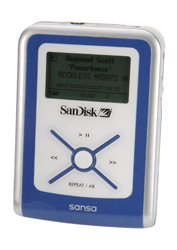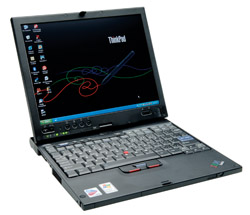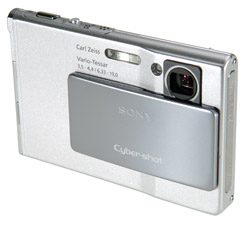When Stanford University’s robotic Volkswagen Touareg, “Stanley,” won the Grand Challenge last week, robot enthusiasts everywhere cheered. By completing a 210-kilometer course over difficult desert terrain in just under seven hours, Stanley set an unprecedented milestone for autonomous vehicles.
Even more amazingly, four other teams’ vehicles also completed the course, with slightly slower times.
“It’s kind of like if you had challenged people to fly across the Atlantic, and instead of one guy [making it], just Lindbergh, you had five guys flying across at the same time,” says Sebastian Thrun, an associate professor of computer science at Stanford and the leader of the Stanford team.
The Lindbergh analogy is apt. Both the famed aviator and the Stanford team were motivated to accomplish their feat by the tantalizing promise of prize money. In Charles Lindbergh’s case, it was a $25,000 purse that wealthy hotelier Raymond Orteig offered, in 1919, for the first nonstop aircraft flight between New York and Paris. In 1927, a 25-year-old Lindbergh finally captured the prize, by taking off from Long Island and landing in Paris 33 1/2 hours later, in a $10,000, custom-built monoplane named after his financial backers’ hometown, St. Louis.
For the Stanford team, winning the Grand Challenge meant collecting the $2 million prize put up by the U.S. Defense Advanced Research Projects Agency (DARPA) earlier this year. Not a bad return on a project that Thrun estimates cost about $500,000.
The Grand Challenge is just the latest example of how prize money can be an effective — and extremely efficient — way to stimulate rapid technological development. And while prizes might not work in every field of technological research, observers say it might be time to explore the prize model more deeply, particularly as the United States launches several multibillion-dollar projects, such as replacing the Space Shuttle, returning to the Moon, and sending humans to Mars.
DARPA’s mission is to stimulate research in defense-related areas, then leave development of viable applications to others. That’s exactly how this year’s Grand Challenge played out, with 195 teams entering the competition, five teams successfully completing the course — and a whole new crop of inventors, engineers, computer scientists, entrepreneurs, and even high-school students stimulated to enter the field of autonomous vehicles.
That will undoubtedly pay dividends for the military in the future, since many of the universities and corporations that fielded Grand Challenge teams also work on DARPA projects. Thrun’s work, for instance, has been attracting DARPA funding for more than eight years, and he intends to continue applying for defense grants in the future.
Competing in the Challenge offered benefits to the teams and their sponsors, too, even for those that didn’t win, says Jon Feiber, a managing partner at Menlo Park, CA-based Mohr Davidow Ventures, a venture capital firm that cosponsored the Stanford team. Among the payoffs were educating students, raising the level of interest in (and funding for) robotics, forging partnerships between academic engineering departments and industry, and making connections among researchers, students, and DARPA personnel.
Of course the Grand Challenge isn’t the only recent feat of engineering inspired by the tantalizing promise of a pot of lucre for the victors. Last year’s Ansari X Prize paid $10 million to aircraft designer Burt Rutan’s SpaceShipOne team for completing two suborbital space flights at an altitude of at least 100 kilometers in the span of two weeks.
It’s hard to argue with the success of the X Prize, without which private space flight might still be languishing in an embryonic state. Indeed, several entrepreneurial ventures are now planning commercial space flights, including Richard Branson’s Virgin Galactic, PayPal founder Elon Musk’s SpaceX, video-game developer John Carmack’s Armadillo Aerospace, and Amazon.com founder Jeff Bezos’s Blue Origin.
The Federal Aviation Administration even opened an Office of Commercial Space Transportation after SpaceShipOne’s historic flight, and has begun drafting regulations for commercial space travel that it expects to begin in 2007 or 2008.
If prizes are so effective at motivating research and pushing innovators to new heights, why not offer more of them? DARPA estimates that it spent $22 million on the Grand Challenge, which included the $2 million prize and the cost of organizing, hosting, and publicizing the event. That’s a drop in the bucket compared with DARPA’s 2005 budget of $3 billion. The rest of the agency’s money is doled out primarily through grants and contracts.
“The prize approach is particularly useful in energizing a community and giving people an incentive to become involved in researching a technology area of interest to DOD,” says Jan Walker, a spokesman for DARPA. In fact, DARPA officials are so pleased with the results, says Walker, that they plan to sponsor another Grand Challenge in the future, in a yet-to-be-named field.
Yet contests may be appropriate for only some kinds of research or take research only so far. The highly successful Grand Challenge and the X Prize were both built around a well-defined problem, had clear objectives, and presented challenges that were both difficult and rewarding for a wide variety of contenders to tackle.
“I don’t think the contest model works broadly,” says Mohr Davidow Venture’s Feiber. “It works for certain objectives, but you couldn’t grossly restructure research around this kind of system. But when it does work, it has enormous benefits.”
Stanford’s Thrun agrees. “You could not do everything by a competition of this type, because it’s entirely unsustainable,” Thrun says. “It was an important part of my fundraising that this was a unique event, and that it was really big.” If this year’s event had been the fifth, or the 25th, Grand Challenge instead of the second, Thrun says, he would have been unable to raise the $500,000 to build the machine. In other words, part of the attraction of the Grand Challenge was its uniqueness and headline-worthiness — qualities that could fade fast if similar contests happen every year.
Still, considering the salutary effects of the Grand Challenge and X Prize, it’s reasonable to believe that a few more such contests might be useful for advancing research in key areas.
Here’s a modest proposal: NASA has a five-year, $12 billion budget for creating new spacecraft that can take humans safely to the Moon and, eventually, Mars. Why not devote just one percent of that budget to a prize aimed at encouraging parallel research by private industry?
Although NASA has set up a “Centennial Challenges” program to stimulate innovation by offering prizes, all of the contests so far are relatively minor, such as a $250,000 prize for developing the best new glove for astronauts.
A much larger bounty — say, $120 million for sending humans to orbit the Moon and returning them safely — would be a powerful stimulus to space research. Certainly, it would generate innovation, and it might also produce some commercial spacecraft, launch vehicles, or other tools that NASA would find useful in achieving its own goals. Perhaps most importantly, it would likely boost popular opinion of space travel, turning it from a federal boondoggle into a shared vision and common goal. In short, it might be a winner for an enterprising team of engineers — and NASA.
Link: Eyes on the Prize
Link broken? Try the Wayback Machine.

 If you prefer the McDonald’s dollar menu to dining at the Ritz, Friday night TV movies to Broadway shows, and big blocks of Velveeta to imported French Brie, then the SanDisk Sansa e130 is the perfect audio player for you. Just don’t ask it to deliver top-drawer audio quality or usability.
If you prefer the McDonald’s dollar menu to dining at the Ritz, Friday night TV movies to Broadway shows, and big blocks of Velveeta to imported French Brie, then the SanDisk Sansa e130 is the perfect audio player for you. Just don’t ask it to deliver top-drawer audio quality or usability. To some, the Tablet PC operating system ranks right up there with Microsoft Bob, Clippy the Office Wizard, and Steve Ballmer as one of Microsoft’s most obnoxious, useless creations. The IBM ThinkPad X41 Tablet is unlikely to change the minds of the haters. But for more open-minded folks, the X41 shows that it is possible to make a tablet that’s usable, functional, well built, and even attractive.
To some, the Tablet PC operating system ranks right up there with Microsoft Bob, Clippy the Office Wizard, and Steve Ballmer as one of Microsoft’s most obnoxious, useless creations. The IBM ThinkPad X41 Tablet is unlikely to change the minds of the haters. But for more open-minded folks, the X41 shows that it is possible to make a tablet that’s usable, functional, well built, and even attractive. Sony’s slimmest Cyber-shot, the DSC-T7, is more than just a camera. It’s skinny enough that you could use it to shim up a wobbly kitchen table or to wedge a door shut. Or you could weld on a little extra hardware and wear it as a belt buckle.
Sony’s slimmest Cyber-shot, the DSC-T7, is more than just a camera. It’s skinny enough that you could use it to shim up a wobbly kitchen table or to wedge a door shut. Or you could weld on a little extra hardware and wear it as a belt buckle. My
My